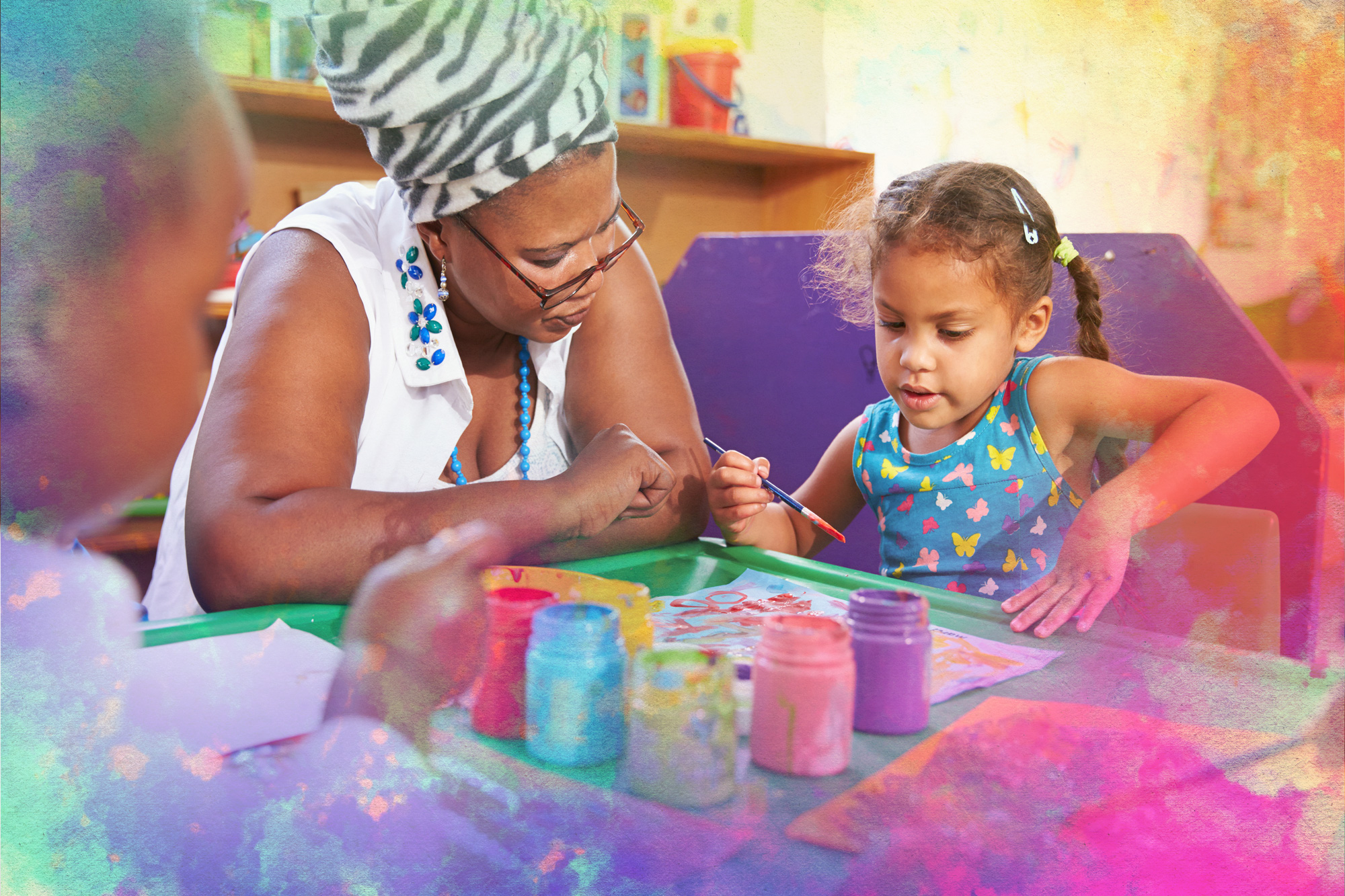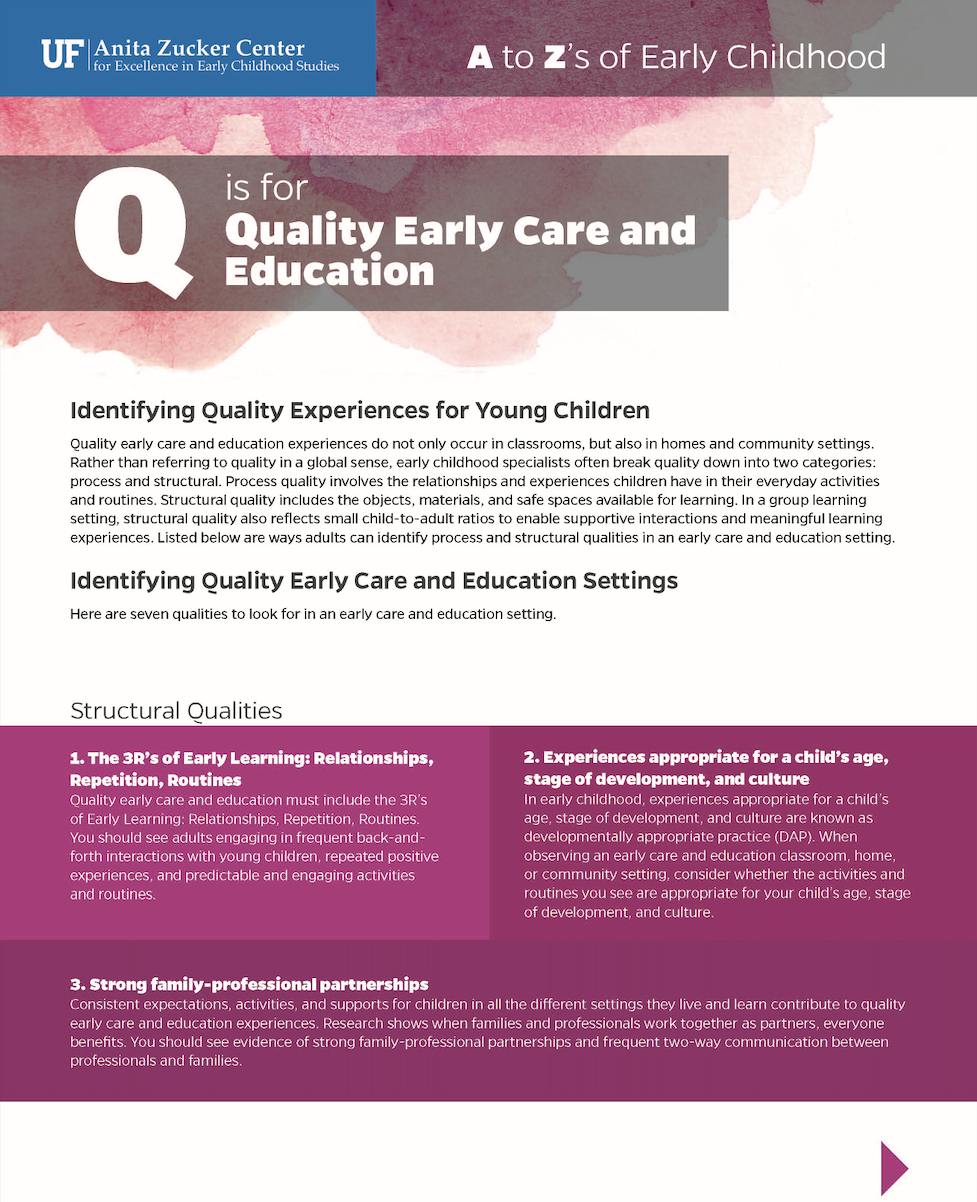A to Z’s of Early Childhood
The Science of Child Development and Learning
Q is for Quality Early Care and Education
Identifying Quality Experiences for Young Children
Quality early care and education experiences do not only occur in classrooms, but also in homes and community settings. Rather than referring to quality in a global sense, early childhood specialists often break quality down into two categories: process and structural. Process quality involves the relationships and experiences children have in their everyday activities and routines. Structural quality includes the objects, materials, and safe spaces available for learning. In a group learning setting, structural quality also reflects small child-to-adult ratios to enable supportive interactions and meaningful learning experiences. Listed below are ways adults can identify process and structural qualities in an early care and education setting.

Identifying Quality Early Care and Education Settings
Here are seven qualities to look for in an early care and education setting.
Process Qualities
1. The 3R’s of Early Learning: Relationships, Repetition, Routines ™
Quality early care and education must include the 3R’s of Early Learning: Relationships, Repetition, Routines ™. You should see adults engaging in frequent back-and-forth interactions with young children, repeated positive experiences, and predictable and engaging activities and routines.
2. Experiences appropriate for a child’s age, stage of development, and culture
In early childhood, experiences appropriate for a child’s age, stage of development, and culture are known as developmentally appropriate practice (DAP). When observing an early care and education classroom, home, or community setting, consider whether the activities and routines you see are appropriate for your child’s age, stage of development, and culture.
3. Strong family-professional partnerships
Consistent expectations, activities, and supports for children in all the different settings they live and learn contribute to quality early care and education experiences. Research shows when families and professionals work together as partners, everyone benefits. You should see evidence of strong family-professional partnerships and frequent two-way communication between professionals and families.
Structural Qualities
4. Safe spaces for children to learn
For young children, it is essential that their physical and emotional safety are monitored, acknowledged, and supported so that all children feel safe and supported in the learning setting. Look for a high-quality early care and education environment that appears physically and emotionally safe.
Safe Spaces in Quality Early Care
| Physical Safety | Emotional Safety |
|
|
5. Appropriate and interesting materials
Access to safe, engaging, and developmentally appropriate materials is essential for child development and learning. Look for age-appropriate and culturally relevant toys, books, and learning materials such as crayons, paint, and paper, as well as sturdy and interesting toys that support play and exploration.
6. Adults who understand and continue to learn about child development and learning
Children’s success in a learning environment depends on the knowledge, skills, and dispositions of the adults. It is essential that early childhood practitioners and other adults in the lives of children have opportunities to enhance their knowledge and skills so they can provide a nurturing and supportive learning environment for young children. A skilled and qualified adult has the ability to connect with each child and tailor learning opportunities to meet their needs.
7. Diverse early childhood experiences
While consistency is important in supporting children’s development and learning, novel and diverse enrichment experiences are also important. Local parks, libraries, and museums often have programs designed specifically to support meaningful interactions among adults and children that support early learning. Planned trips to participate in these community programs expand children’s experiences and provide opportunities to learn new vocabulary and engage in social interactions with other children and adults.
What We are Doing
The Anita Zucker Center and our collaborators are helping families and practitioners identify quality early care and education settings and support community programs that foster these quality early learning experiences.
Learn more:
- CHILD Center for Early Learning
The Anita Zucker Center partners with local groups, including the Southwest Advocacy Group (SWAG), the Early Learning Coalition of Alachua County, and Episcopal Children’s Services to maintain the CHILD Center for Learning, a model high-quality early care and education demonstration program in Gainesville, FL. -
Transformative Professional Development for Early Care and Education Program Providers
The Anita Zucker Center collaborates with the Early Learning Coalition of Alachua County and the CHILD Center to expand high-quality care and education through our professional development initiatives across Alachua County. - Children’s Trust of Alachua County
Our Director, Dr. Patricia Snyder, Distinguished Professor, serves on the Advisory Board for the Children’s Trust of Alachua County, which helps direct funding for children’s services throughout the county.
Other Resources
- Child Care Quality Checklists
This Child Care Services Association website offers downloadable Child Care Center and Family Child Care Home Checklists to use when considering an early care and education program for young children. - The Building Blocks of High-Quality Early Childhood Education Programs
Read this brief from the Learning Policy Institute to learn more about the research-based elements of high-quality early childhood care and education programs.
Books and Articles by Center Members and Collaborators
- Decker, C. A., Decker, J. R., Freeman, N. K., & Knopf, H. T. (2009). Planning and administering early childhood programs (9th ed.). Pearson Merrill Prentice-Hall.
- Knopf, H. T., & Swick, K. J. (2008). Using our understanding of families to strengthen family involvement. Early Childhood Education Journal, 35(5), 419-427. https://doi.org/10.1007/s10643-007-0198-z
- Carta, J., & Snyder, P. (2019). Fifty years of research on children with disabilities and their families: From changing behaviors to transforming lives. In B. H. Wasik & S. L. Odom (Eds.), Celebrating 50 years of child development research: Past, present, and future perspectives (pp. 235-254). Brookes.
- Snyder, P. A., Rakap, S., Hemmeter, M. L., McLaughlin, T. W., Sandall, S., & McLean, M. E. (2015). Naturalistic instructional approaches in early learning: A systematic review. Journal of Early Intervention, 37(1), 69-97. https://doi.org/10.1177/1053815115595461
References
- Bronfenbrenner, U. (1992). Ecological systems theory. In R. Vasta (Ed.), Six theories of child development: Revised formulations and current issues (pp. 187-248). Jessica Kingsley Publishers.
- Center on the Developing Child. (2007). The science of early childhood development (InBrief). https://developingchild.harvard.edu/resources/inbrief-science-of-ecd/
- Dunst, C. J., Bruder, M. B., Trivette, C. M., Hamby, D., Raab, M., & McLean, M. (2001). Characteristics and consequences of everyday natural learning opportunities. Topics in Early Childhood Special Education, 21(2), 68-92. doi.org/10.1177/027112140102100202
- Dunst, C. J., Hamby, D., Trivette, C. M., Raab, M., & Bruder, M. B. (2000). Everyday family and community life and children’s naturally occurring learning opportunities. Journal of Early Intervention, 23(3), 151-164. doi.org/10.1177/10538151000230030501
- Epstein, A. S. (2015). The intentional teacher: Choosing the best strategies for young children’s learning. National Association for the Education of Young Children.
- Jalongo, M. R., Fennimore, B. S., Pattnaik, J., Laverick, D. M., Brewster, J., & Mutuku, M. (2004). Blended perspectives: A global vision for high-quality early childhood education. Early Childhood Education Journal, 32(3), 143-155. https://doi.org/10.1023/B:ECEJ.0000048966.13626.be
- Laughlin, L. (2013). Who’s minding the kids? Child care arrangements: Spring 2011 (Current Population Reports, Report No. P70-135 ). United States Census Bureau. https://www2.census.gov/library/publications/2013/demo/p70-135.pdf
- National Research Council, & Institute of Medicine. (2000). From neurons to neighborhoods: The science of early childhood development. National Academy Press. https://doi.org/10.17226/9824
- National Survey of Early Care and Education Project Team. (2015). Fact sheet: Who is providing home-based early care and education? (OPRE Report No. 2015-43). Office of Planning, Research and Evaluation, Administration for Children and Families, U.S. Department of Health and Human Services. https://www.acf.hhs.gov/sites/default/files/documents/opre/hb_providers_fact_sheet_toopre_041715_508.pdf
- Rathbun, A., Zhang, A., & Snyder, T. D. (2016). Primary early care and education arrangements and achievement at kindergarten entry (NCES 2016-070). National Center for Education Statistics, Institute of Education Sciences, U.S. Department of Education. https://nces.ed.gov/pubs2016/2016070.pdf
Receive Additional Support
The complete 3R’s of Early Learning downloadable video recordings (including the A to Z’s of Early Childhood) for use in the field of childhood development to facilitate learning are available for purchase.
If you would like to purchase these resources or speak with a member of our team for help in providing professional development, please complete this contact form.

